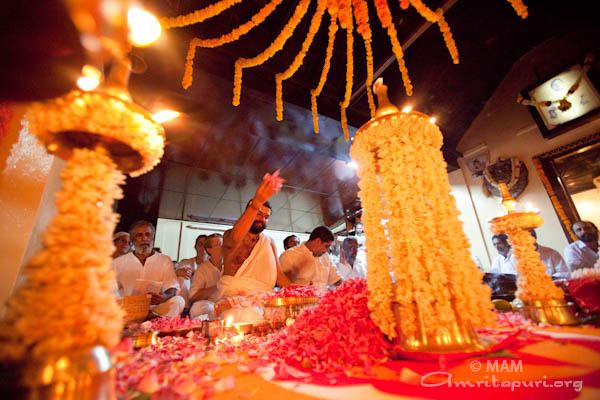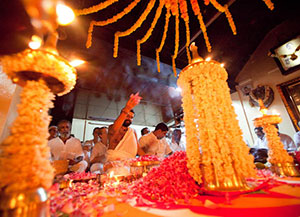Kali Pujas take place on the veranda of the Kalari at Amritapuri, which is prepared with exquisitely coloured drawings, made with coloured powders. The diagram represents the peetham (seat) of the goddess who is symbolically present in the form of a tall lamp standing in the centre.
Kali is the compassionate Mother in Her fierce aspect. Her wrath, which destroys negative tendencies, is limitless and so too is Her Love. For Her sincere devotees, Kali is the most loving and protective aspect of the Divine.

Union with the Supreme Self is attained when the obstacle of our judgmental mind is removed. This judgmental mind includes our desires and selfishness (ego). The Kali Puja is performed to remind us that even unpleasant events are a blessing, if we can only learn the lesson inherent in them. When we do understand, our sense of duality diminishes, and we come closer to the Self. The puja is communal and many residents attend.
The central aspect of the puja is the symbolic offering to God of the five elements of creation. Our body is composed from these five elements: ether, air, fire, water and earth. The puja symbolises the surrender of the devotee to the Lord. Each element is represented by a material symbol, such as flowers, lamps, etc.
These are offered at the foot of the lamp. The desire of the devotee to offer his or her surrender is effected by these symbolic offerings. While the offerings are being made, all the attendants chant the holy names of Kali.
The puja starts with a worship of the Guru and of Ganesha, the symbolic remover of obstacles. The puja ends when the pujari gives the offerings, sanctified by the puja, to the devotees. The flame (symbolic of Consciousness) and sweet pudding (symbolic of union with God) are offered to the devotees.
The Kali Puja is very effective in removing the obstacles to progress on the spiritual path. This puja is conducted every month in the Kalari on ‘”Kartika” days—the birth star of Amma—and at special requests on other days.

